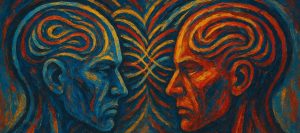The soul becomes dyed with the color of its thoughts.
– Marcus Aurelius
Visualization, or the practice of imagining a specific outcome in vivid detail, has been used for centuries by high-performers, athletes, and leaders to achieve success. It’s not just about positive thinking—it’s a scientifically proven technique that activates the same neural pathways as actual experiences, making your brain and body “rehearse” success.
Visualization can boost your confidence, reduce anxiety, and make you feel braver when facing challenges. Let’s explore how visualization works and how you can use it to enhance your everyday life.
How Visualization Works
Visualization taps into the brain’s ability to create mental imagery, a process that uses the same neural circuits as actual experiences. When you visualize yourself succeeding at a task, your brain interprets this mental rehearsal as if it were the real thing, reinforcing neural connections that build confidence and improve performance.
A study by Dr. Guang Yue at the Cleveland Clinic Foundation (1996) found that mental training—such as visualizing strength exercises—can result in actual physical improvement. In the study, participants who visualized strength training increased their muscle strength by nearly 13%, even without engaging in physical exercise. This shows that visualization doesn’t just stay in your mind—it has tangible effects on your body.
Similarly, research published in the Journal of Neurophysiology (1995) found that when athletes mentally rehearse their performance, their brain activity mirrors what would happen during the actual event. This is why elite athletes, from Olympic gold medalists to professional basketball players, incorporate visualization into their training routines. It’s not just about boosting confidence but also about priming the brain and body to act.
The Science Behind Visualization
Visualization works by stimulating the same neural pathways as real actions, allowing the brain to prepare for success. When you vividly imagine yourself succeeding, your brain sends signals to your muscles to “practice” the movements or actions required. Over time, this mental rehearsal strengthens the neural circuits that control these actions, making it easier to execute them when the time comes.
Research shows that visualization activates the motor cortex and cerebellum, parts of the brain responsible for motor skills and coordination. By repeatedly visualizing success, you’re training your brain to perform better in real-life situations, reducing the fear and anxiety that often accompany high-pressure tasks.
How Visualization Boosts Confidence and Courage
Visualization helps boost confidence because it allows you to mentally experience success before it happens. When you visualize yourself overcoming challenges or excelling in a task, it primes your brain to believe that success is not only possible but expected. This expectation reduces anxiety and increases your sense of control, helping you approach challenges with more courage.
Visualization is particularly effective for situations where fear or anxiety typically take over, such as:
NEW! Put the principles from this article into practice with the free courage-boosting MaArtial app on the App Store for iOs and Play Store for Android.
- Public speaking: Visualize yourself delivering a speech calmly and confidently. Picture the audience reacting positively, and imagine the sense of accomplishment after you’ve finished.
- Job interviews: Mentally rehearse your responses to tough questions and see yourself answering with clarity and confidence. Visualize a successful interview that ends with you getting the job.
- Sports or physical challenges: Picture yourself crossing the finish line, making the winning shot, or completing a difficult workout. Your brain will start to prepare your body for this outcome, reducing nerves and boosting performance.
How to Use Visualization in Daily Life
- Set Your Intention: Before you begin visualizing, clarify what you want to achieve. Whether it’s acing a presentation, passing an exam, or handling a difficult conversation, make sure your goal is clear.
- Find a Quiet Space: Choose a calm environment where you can focus without distractions. Visualization works best when you’re relaxed and able to concentrate fully on your mental imagery.
- Engage All Your Senses: When visualizing, don’t just imagine the outcome—make it as vivid as possible. Picture what you see, hear, and feel during the process. For example, if you’re visualizing a successful job interview, imagine the room, your outfit, the tone of your voice, and the interviewer’s reactions.
- Focus on Success: Always visualize a positive outcome. See yourself performing confidently, overcoming obstacles, and achieving your goal. This builds a mental blueprint of success, helping your brain expect that outcome when you face the real-life challenge.
- Practice Regularly: Like any skill, visualization requires regular practice. The more frequently you rehearse success in your mind, the more natural and automatic it will feel when the time comes to perform. Try incorporating visualization into your daily routine—just a few minutes before a big event can make a significant difference.
The Benefits of Visualization
- Increased Confidence: By “practicing” success in your mind, you’ll feel more confident when you face the actual situation. The brain becomes more comfortable with the scenario, making it easier to stay calm and focused.
- Reduced Anxiety: Visualization helps reduce anxiety by allowing you to mentally rehearse how you’ll handle stressful situations. This preparation minimizes the fear of the unknown and helps you feel in control.
- Improved Performance: Whether you’re preparing for a big presentation, a sports competition, or even a daily task, visualization can improve your performance. By creating a mental image of success, you prime your brain and body for action.
- Stronger Resilience: Visualization also strengthens resilience by helping you mentally prepare for challenges. When you imagine yourself overcoming obstacles, you build the mental toughness needed to face adversity with courage.
Visualizing Confidence and Success
Visualization is a powerful tool that allows you to mentally rehearse success, making you braver and more confident when faced with real-life challenges. By engaging your brain in the process, you prepare yourself to act with confidence, reducing anxiety and improving performance.
The science behind visualization shows that it’s not just a mental exercise—when practiced consistently, it can have real, tangible effects on your life. Whether you’re facing a job interview, public speaking event, or any other challenge, visualization helps you build the courage to succeed. Start small, practice regularly, and watch how this powerful technique transforms your confidence.












